指示语deixis
- 格式:doc
- 大小:53.00 KB
- 文档页数:5
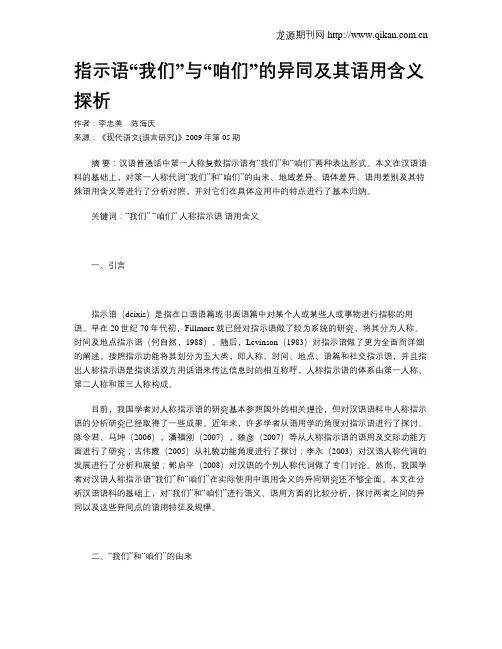
指示语“我们”与“咱们”的异同及其语用含义探析作者:李忠美陈海庆来源:《现代语文(语言研究)》2009年第05期摘要:汉语普通话中第一人称复数指示语有“我们”和“咱们”两种表达形式。
本文在汉语语料的基础上,对第一人称代词“我们”和“咱们”的由来、地域差异、语体差异、语用差别及其特殊语用含义等进行了分析对照,并对它们在具体应用中的特点进行了基本归纳。
关键词:“我们” “咱们” 人称指示语语用含义一、引言指示语(deixis)是指在口语语篇或书面语篇中对某个人或某些人或事物进行指称的用语。
早在20世纪70年代初,Fillmore就已经对指示语做了较为系统的研究,将其分为人称、时间及地点指示语(何自然,1988)。
随后,Levinson(1983)对指示语做了更为全面而详细的阐述,按照指示功能将其划分为五大类,即人称、时间、地点、语篇和社交指示语,并且指出人称指示语是指谈话双方用话语来传达信息时的相互称呼,人称指示语的体系由第一人称、第二人称和第三人称构成。
目前,我国学者对人称指示语的研究基本参照国外的相关理论,但对汉语语料中人称指示语的分析研究已经取得了一些成果。
近年来,许多学者从语用学的角度对指示语进行了探讨。
陈令君、马坤(2006),潘福刚(2007),赖彦(2007)等从人称指示语的语用及交际功能方面进行了研究;古伟霞(2005)从礼貌功能角度进行了探讨;李永(2003)对汉语人称代词的发展进行了分析和展望;郭启平(2008)对汉语的个别人称代词做了专门讨论。
然而,我国学者对汉语人称指示语“我们”和“咱们”在实际使用中语用含义的异同研究还不够全面。
本文在分析汉语语料的基础上,对“我们”和“咱们”进行语义、语用方面的比较分析,探讨两者之间的异同以及这些异同点的语用特征及规律。
二、“我们”和“咱们”的由来(一)“我们”的由来表示第一人称的“我”最早见于甲骨刻辞中,表达的都是复数意义,相当于现代汉语中的“我们”。

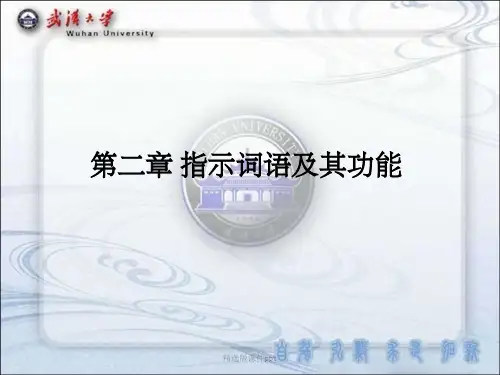

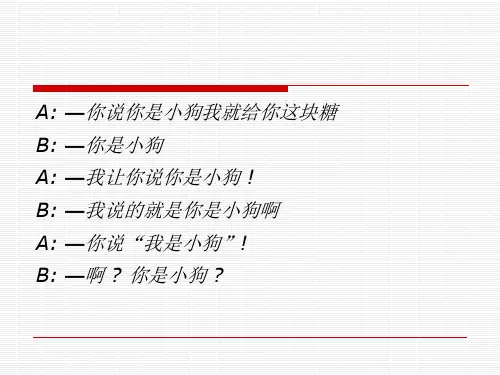
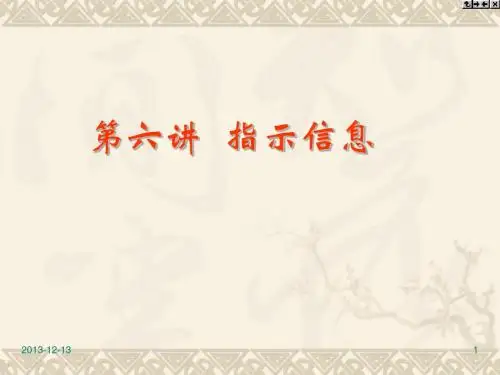
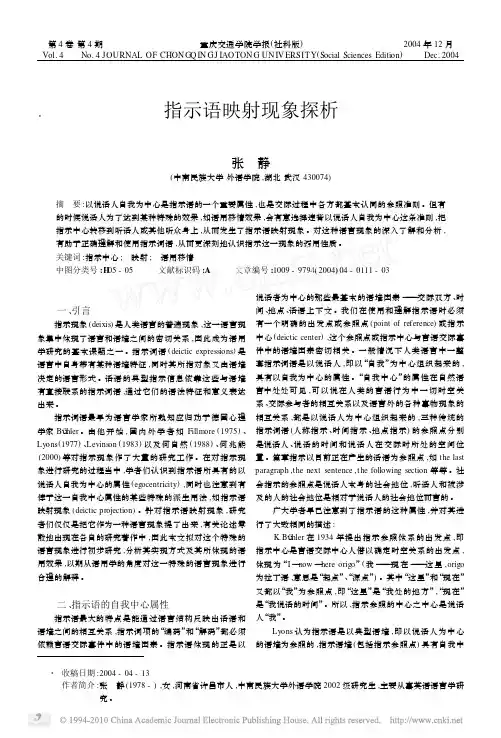
第4卷第4期 重庆交通学院学报(社科版) 2004年12月Vol.4 No.4JOURNAL OF CHON GQIN G J IAOTON G UNIVERSITY(Social Sciences Edition) Dec.2004指示语映射现象探析Ξ张 静(中南民族大学外语学院,湖北武汉430074)摘 要:以说话人自我为中心是指示语的一个重要属性,也是交际过程中各方都基本认同的参照准则。
但有的时候说话人为了达到某种特殊的效果,如语用移情效果,会有意选择违背以说话人自我为中心这条准则,把指示中心转移到听话人或其他听众身上,从而发生了指示语映射现象。
对这种语言现象的深入了解和分析,有助于正确理解和使用指示词语,从而更深刻地认识指示这一现象的语用性质。
关键词:指示中心; 映射; 语用移情中图分类号:H05-05 文献标识码:A 文章编号:1009-9794(2004)04-0111-03一、引言指示现象(deixis)是人类语言的普遍现象,这一语言现象集中体现了语言和语境之间的密切关系,因此成为语用学研究的基本课题之一。
指示词语(deictic expressions)是语言中自身带有某种语境特征,同时其所指对象又由语境决定的语言形式。
话语的典型指示信息依靠这些与语境有直接联系的指示词语,通过它们的语法特征和意义表达出来。
指示词语最早为语言学家所熟知应归功于德国心理学家Bühler。
由他开始,国内外学者如Fillmore(1975)、Lyons(1977)、Levinson(1983)以及何自然(1988)、何兆熊(2000)等对指示现象作了大量的研究工作。
在对指示现象进行研究的过程当中,学者们认识到指示语所具有的以说话人自我为中心的属性(egocentricity),同时也注意到有悖于这一自我中心属性的某些特殊的派生用法,如指示语映射现象(deictic projection)。
针对指示语映射现象,研究者们仅仅是把它作为一种语言现象提了出来,有关论述零散地出现在各自的研究著作中,因此本文拟对这个特殊的语言现象进行初步研究,分析其实现方式及其所体现的语用效果,以期从语用学的角度对这一特殊的语言现象进行合理的解释。
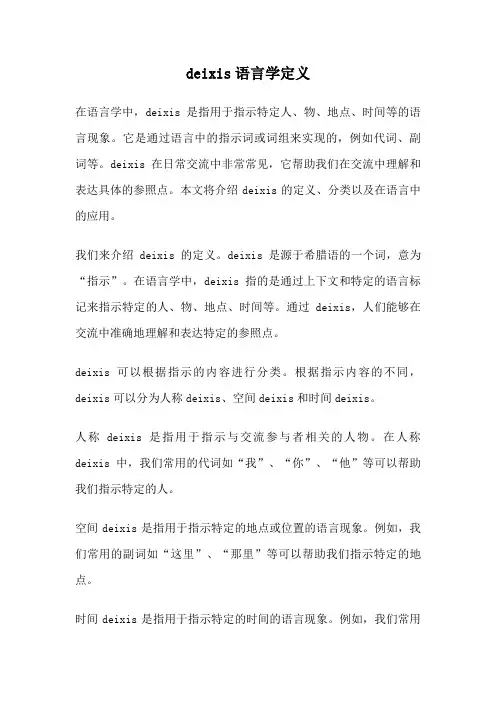
deixis语言学定义在语言学中,deixis是指用于指示特定人、物、地点、时间等的语言现象。
它是通过语言中的指示词或词组来实现的,例如代词、副词等。
deixis在日常交流中非常常见,它帮助我们在交流中理解和表达具体的参照点。
本文将介绍deixis的定义、分类以及在语言中的应用。
我们来介绍deixis的定义。
deixis是源于希腊语的一个词,意为“指示”。
在语言学中,deixis指的是通过上下文和特定的语言标记来指示特定的人、物、地点、时间等。
通过deixis,人们能够在交流中准确地理解和表达特定的参照点。
deixis可以根据指示的内容进行分类。
根据指示内容的不同,deixis可以分为人称deixis、空间deixis和时间deixis。
人称deixis是指用于指示与交流参与者相关的人物。
在人称deixis中,我们常用的代词如“我”、“你”、“他”等可以帮助我们指示特定的人。
空间deixis是指用于指示特定的地点或位置的语言现象。
例如,我们常用的副词如“这里”、“那里”等可以帮助我们指示特定的地点。
时间deixis是指用于指示特定的时间的语言现象。
例如,我们常用的时间状语词如“现在”、“昨天”、“明天”等可以帮助我们指示特定的时间。
除了以上分类,deixis还可以根据指示的方式进行划分。
根据指示方式的不同,deixis可以分为直接deixis和间接deixis。
直接deixis是指通过具体的语言标记来直接指示特定的参照点。
例如,代词“我”、“你”等直接指示特定的人。
间接deixis是指通过上下文信息来间接指示特定的参照点。
例如,当我们说“昨天我去了那里”,虽然没有明确指出“那里”的位置,但通过上下文信息,我们可以推断出“那里”是指昨天我们去过的地方。
在实际的交流中,deixis起着非常重要的作用。
通过deixis,我们可以使交流更加具体和准确。
然而,deixis也存在一些挑战,因为它的理解和表达都依赖于上下文和语境。

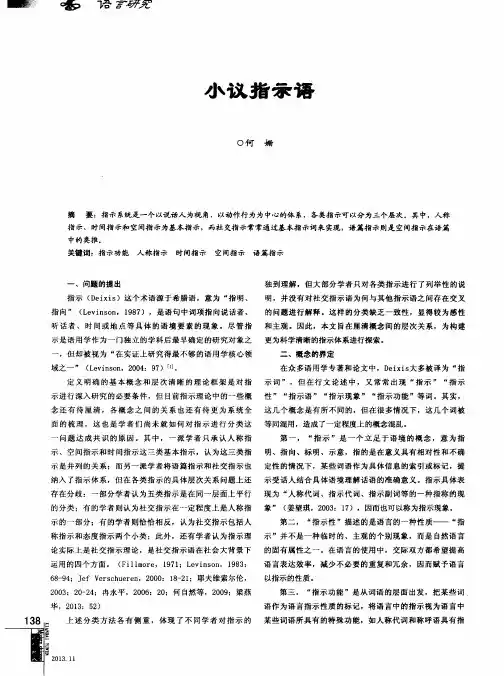
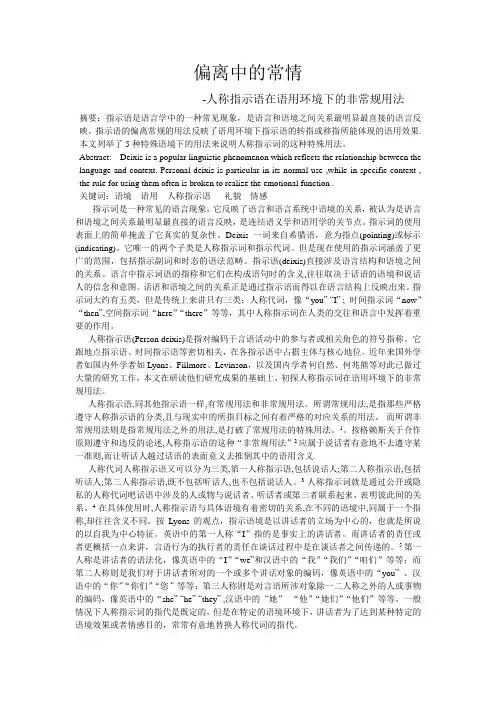
偏离中的常情-人称指示语在语用环境下的非常规用法摘要:指示语是语言学中的一种常见现象,是语言和语境之间关系最明显最直接的语言反映,指示语的偏离常规的用法反映了语用环境下指示语的转指或移指所能体现的语用效果.本文列举了5种特殊语境下的用法来说明人称指示词的这种特殊用法。
Abstract: Deixis is a popular linguistic phenomenon which reflects the relationship between the language and context. Personal deixis is particular in its normal use ,while in specific context , the rule for using them often is broken to realize the emotional function .关键词:语境语用人称指示语礼貌情感指示词是一种常见的语言现象,它反映了语言和语言系统中语境的关系,被认为是语言和语境之间关系最明显最直接的语言反映,是连结语义学和语用学的关节点。
指示词的使用表面上的简单掩盖了它真实的复杂性。
Deixis一词来自希腊语,意为指点(pointing)或标示(indicating)。
它唯一的两个子类是人称指示词和指示代词。
但是现在使用的指示词涵盖了更广的范围,包括指示副词和时态的语法范畴。
指示语(deixis)直接涉及语言结构和语境之间的关系。
语言中指示词语的指称和它们在构成语句时的含义,往往取决于话语的语境和说话人的信念和意图。
话语和语境之间的关系正是通过指示语而得以在语言结构上反映出来。
指示词大约有五类,但是传统上来讲只有三类:人称代词,像“you” “I” ; 时间指示词“now”“then”,空间指示词“here”“there”等等,其中人称指示词在人类的交往和语言中发挥着重要的作用。
指示词“this、that”与“这、那”的差异指示(deixis)是人类语言中带有普遍性的现象,英语中“this”和“that”的出现频率最多。
但根据分析研究,“this”和“that”并不一定能和“这”“那”互译。
标签:指示词这那指示(deixis)是人类语言中普遍性的现象,在任何一种语言中都存在,也是语用学研究的一个重要课题,因为它直接涉及到语言结构和语境之间的密切关系。
根据列文森(Levinson)的归纳,可分为人称指示、时间指示、地点指示、话语指示和社交指示五类。
在英语中,这些词项和语法范畴包括人称代词、指示代词、定冠词以及一些表示地点和时间的副词,在这些指示词中,“this”和“that”的出现频率最多。
但人们往往因文化的差异和思维方式的不同而对它们的理解和表达产生偏差,从而导致在跨文化交流或翻译中出现种种问题。
为此,本文将从语用视角在以下几个方面进行探讨。
一当“this”和“that”作为话语指示(指在说话或行文过程中选择恰当的词汇或语法手段来传达话语中某部分或某方面的指示信息)时,“这”不一定是“this”,例如,汉语中用于总结即回指时,把刚刚过去的当做”近”,而“这”(this)是近指,因此在说了一段话之后常说“这就是我的意见。
”而英语则认为已经过去的就是“远”,所以用“that”,即应说成“That was my idea.”如果在翻译成汉语时按照英语的思维和观察事物的习惯说成“那就是我的意见。
”会使中国人听起来很不地道。
当然这不是因为违反语法规则或用词不当引起的失误,而是因思维方式和习惯的不同或观察事物的角度、范围有差异而造成的语言表达和理解上的失误。
二“this”和“that”也可用于方位指示(指话语涉及的地点)。
方位指示信息来自话语中有关物体的方位或说话时说话人和听话人双方所处的位置。
我们通常认为靠近说话人的位置用“this”,离说话人远的位置用“that”。
但在某些交际语境中,这种空间距离上的差别显得不那么重要,“this”和“that”之间的这种差别就淡化了。
deixis语言学定义Deixis(指示)是语言学中的一个重要概念,用于描述语言中用于指示特定时间、地点、人物或对象的词语或表达方式。
它在人类日常交流中起着至关重要的作用,帮助人们进行有效的沟通和理解。
在语言中,我们经常使用一些指示词,例如代词、副词、介词短语等,来指示特定的事物。
这些指示词可以根据上下文来理解其具体意义,因此它们的含义是相对的,而不是绝对的。
比如,“这个苹果”在不同的情境下可以指代不同的苹果,取决于说话者和听话者所处的位置和时间。
Deixis可以分为三个主要的类型:人称指示、时间指示和空间指示。
人称指示用于指示说话者、听话者和其他相关的人物。
例如,“我”、“你”、“他”等代词都是人称指示的例子。
时间指示用于指示特定的时间点或时间段。
例如,“现在”、“明天”、“过去”等副词都是时间指示的例子。
空间指示用于指示特定的地点或距离。
例如,“这里”、“那边”、“离我很远”等副词和介词短语都是空间指示的例子。
Deixis的使用需要依赖上下文的信息。
同样的指示词在不同的上下文中可能会有不同的含义。
例如,“这个苹果很好吃”在一个水果摊位上的对话中,可能指的是摊位上的某个苹果;而在一个超市里的对话中,可能指的是身边的某个苹果。
因此,理解和使用Deixis 需要考虑到上下文的信息,以便准确传达和理解信息。
除了上下文之外,语言使用者的背景知识和经验也会影响Deixis的理解和使用。
不同的语言和文化背景对Deixis的运用也可能存在差异。
例如,在一些语言中,空间指示更加重要,而在另一些语言中,时间指示更加重要。
因此,了解不同语言和文化背景对Deixis的运用习惯是学习和理解语言的重要一步。
Deixis在日常交流中起着至关重要的作用。
它帮助我们在沟通中准确定义时间、地点、人物和对象,使得交流更加准确和具体。
没有Deixis,我们将无法有效地指示和引用特定的事物,交流将变得困难和模糊。
因此,学习和理解Deixis对于语言学习者和研究者来说至关重要。
指示语deixis话语中跟语境相联系的表示指示信息的词语,就叫做指示语。
指示是语用研究中一个重要概念,涉及到一些词语,如代词、称谓、时间处所词语等。
这些词语的具体或确切的指称意义,必须结合具体的语境,才能准确理解。
指示语主要有:1、人称指示。
称指示是话语中关于人物人称的指示。
最典型的是人称代词,又分第一人称指示、第二人称指示、第三人称指示。
2、时间指示。
时间指示是话语中关于时间的指示。
时间是一个抽象的概念,人们只能人为地选定一些参照点。
在言语交际中,时间指示是以说话时刻作为参照点来计算和理解的。
3、空间指示。
空间指示是话语中关于处所、方位的指示。
空间指示主要有:表示方位和处所的名词、副词、指示代词,具有位移意义的动词如“来”“去”“走”“离开”“到达”等。
4、话语指示。
话语指示又称语段指示、上下文指示,是用来指明话语中部分与部分之间关系的。
由于言语交际是在一定的时间、空间中展开的,所以话语指示与时间指示、空间指示有密切关系,有些时间指示、空间指示同时也是话语指示。
5、社交指示。
社交指示是用来指明发话人和受话人之间,或发话人跟所谈及的人(第三方、之间的社会关系的词语。
DeixisFrom Wikipedia, the free encyclopediaIn linguistics, deixis refers to the phenomenon wherein understanding the meaning of certain words and phrases in an utterance requires contextual information. Words are deictic if their semantic meaning is fixed but their denotational meaning varies depending on time and/or place. Words or phrases that require contextual information to convey any meaning - for example, English pronouns - are deictic. Deixis is closely related to both indexicality and anaphora, as will be further explained below. Although this article deals primarily with deixis in spoken language, the concepts can apply to written language, gestures, and communication media as well. And even though this article is primarily concerned with English, deixis is believed to be a feature (to some degree) of all natural languages.[1]The term’s origin is Ancient Greek: δεῖξις ""display, demonstration, or reference"", the meaning "point of reference" in contemporary linguistics having been taken over from Chrysippus.[2Types of deixis[edit]Traditional categoriesPossibly the most common categories of contextual information referred to by deixis are those of person, place, and time - what Fillmore calls the “major grammaticalized types” of deixis.[3] [edit]PersonPerson deixis concerns itself with the grammatical persons involved in an utterance, (1) those directly involved (e.g. the speaker, the addressee), (2) those not directly involved (e.g. overhearers—those who hear the utterance but who are not being directly addressed), and (3) those mentioned in the utterance.[4] In English, the distinctions are generally indicated by pronouns. The following examples show how. (The person deictic terms are in italics [a signaling notation that will continue through this article].)I am going to the movies.Would you like to have dinner?They tried to hurt me, but he came to the rescue.GenderIn many languages, that only have male and female, referring to gender neutral subjects has different aspects. Objects , or things have their own gender too between male or female. When referring to a genderless object, it is often referred to as a male, though the object is genderless. In the English language, when referring to any character that has no gender, a self-aware entity, it is referred to a male, or as a "He", such as an "it" is inappropriate when calling the sentient object a thing. In many languages, they would address to people as in male, such as a group mixed with men and women is referred to as a male, such as Ils in French. An example would be :A man is responsible for his own soulas opposed toEach person is responsible for his or her own soulcommon in many religious text referring to people of all genders using only the male gender. This can be understood in context, the male gender being used to signify male or female persons.PlacePlace deixis, also known as space deixis, concerns itself with the spatial locations relevant to an utterance. Similarly to person deixis, the locations may be either those of the speaker and addressee or those of persons or objects being referred to. The most salient English examples are the adverbs“here” and “there”and the demonstratives“this” and “that” - although those are far from being the only deictic words.[3]Some examples:I enjoy living in this city.Here is where we will place the statue.She was sitting over there.Unless otherwise specified, place deictic terms are generally understood to be relative to the location of the speaker, as inThe shop is across the street.where “across the street” is understood to mean “across the street from where I am right now.”[3] It is interesting to note that while “here” and “there” are often used to refer to locations near to and far from the speaker, respectively, “there” can also refer to the location of the addressee, if they are not in the same location as the speaker. So, whileHere is a good spot; it is too sunny over there.exemplifies the former usage,How is the weather there?is an example of the latter.[4]Languages usually show at least a two-way referential distinction in their deictic system: proximal, i.e. near or closer to the speaker, and distal, i.e. far from the speaker and/or closerto the addressee. English exemplifies this with such pairs as this and that, here and there, etc. In other languages, the distinction is three-way: proximal, i.e. near the speaker, medial, i.e. near the addressee, and distal, i.e. far from both. This is the case in a few Romance languages and in Korean, Japanese, Thai, Filipino and Turkish The archaic Englishforms yon and yonder (still preserved in some regional dialects) once represented a distal category which has now been subsumed by the formerly medial "there".[5]TimeTime, or temporal, deixis concerns itself with the various times involved in and referred to inan utterance. This includes time adverbs like "now", "then", "soon", and so forth, and also different tenses. A good example is the word tomorrow, which denotes the consecutive next day after every day. The "tomorrow" of a day last year was a different day than the "tomorrow" of a day next week. Time adverbs can be relative to the time when an utterance is made (what Fillmore calls the "encoding time", or ET) or when the utterance is heard (Fillmore’s "decoding time", or DT).[3] While these are frequently the same time, they can differ, as in the case of prerecorded broadcasts or correspondence. For example, if one were to writeIt is raining out now, but I hope when you read this it will be sunny.the ET and DT would be different, with the former deictic term concerning ET and the latterthe DT.Tenses are generally separated into absolute (deictic) and relative tenses. So, forexample, simple English past tense is absolute, such as inHe went.while the pluperfect is relative to some other deictically specified time, as inHe had gone.Other categoriesThough the traditional categories of deixis are perhaps the most obvious, there are other types of deixis that are similarly pervasive in language use. These categories of deixis were first discussed by Fillmore and Lyons.[4][edit]DiscourseDiscourse deixis, also referred to as text deixis, refers to the use of expressions within an utterance to refer to parts of the discourse that contains the utterance — including the utterance itself. For example, inThis is a great story.“this” refers to an upcoming portion of the discourse, and inThat was an amazing day.that” refers to a prior portion of the discourse.Distinction must be made between discourse deixis and anaphora, which is when an expression makes reference to the same referent as a prior term, as inMatthew is an incredible athlete; he came in first in the race.Lyons points out that it is possible for an expression to be both deictic and anaphoric at the same time. In his exampleI was born in London and I have lived here/there all my life.“here” or “there” function anaphorically in their refe rence to London, and deictically in that the choice between “here” or “there” indicates whether the speaker is or is not currently in London.[1]The rule of thumb to distinguish the two phenomenon is as follows: when an expression refers to another linguistic expression or a piece of discourse, it is discourse deictic. When that expression refers to the same item as a prior linguistic expression, it is anaphoric.[4]Switch reference is a type of discourse deixis, and a grammatical feature found in some languages, which indicates whether the argument of one clause is the same as the argument of the previous clause. In some languages, this is done through same subject markers and different subject markers. In the translated example "John punched Tom, and left-[samesubject marker]," it is John who left, and in "John punched Tom, and left-[different subject marker]," it is Tom who left.[citation needed][edit]SocialSocial deixis concerns the social information that is encoded within various expressions, such as relative social status and familiarity. Two major forms of it are the so-called T-V distinctions and honorifics.Usages of deixisIt is helpful to distinguish between two usages of deixis, gestural and symbolic, as well asnon-deictic usages of frequently deictic words. Gestural deixis refers, broadly, to deictic expressions whose understanding requires some sort of audio-visual information. A simple example is when an object is pointed at and referred to as “this” or “that”. However, the category can include other types of information than pointing, such as direction of gaze, tone of voice, and so on. Symbolic usage, by contrast, requires generally only basic spatio-temporal knowledge of the utterance.[4] So, for exampleI broke this finger.requires being able to see which finger is being held up, whereasI love this city.requires only knowledge of the current location. In a similar vein,I went to this city one time . . .is a non-deictic usage of "this", which does not reference anything specific.Rather, it is used as an indefinite article, much the way "a" could be used inits place.。